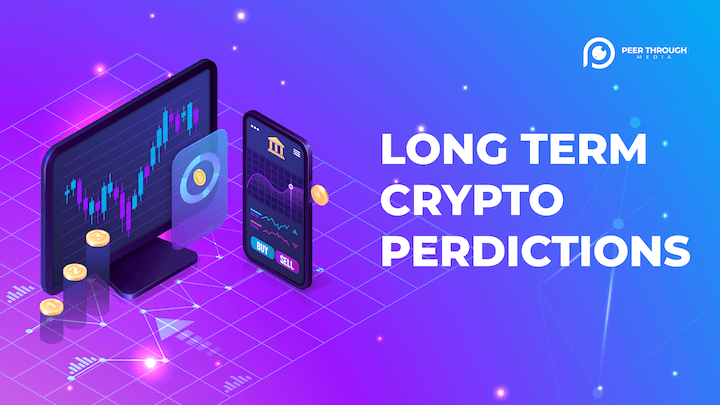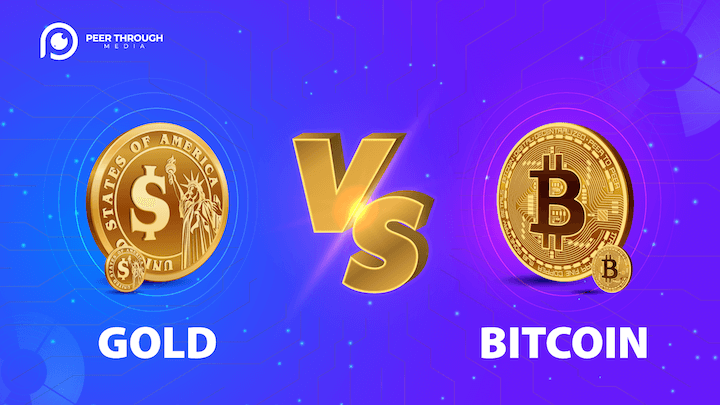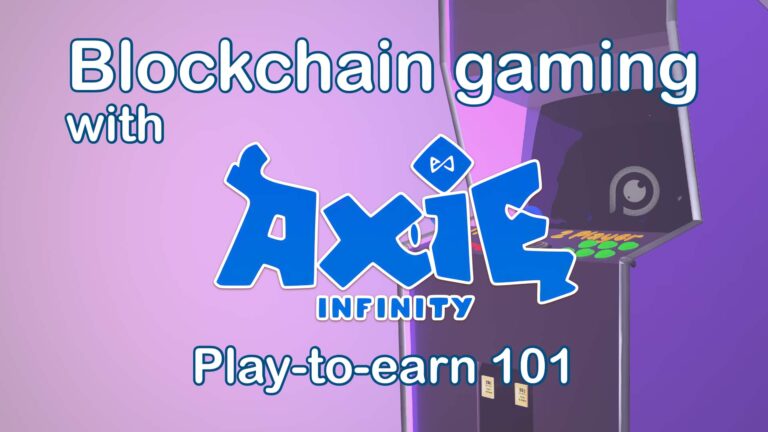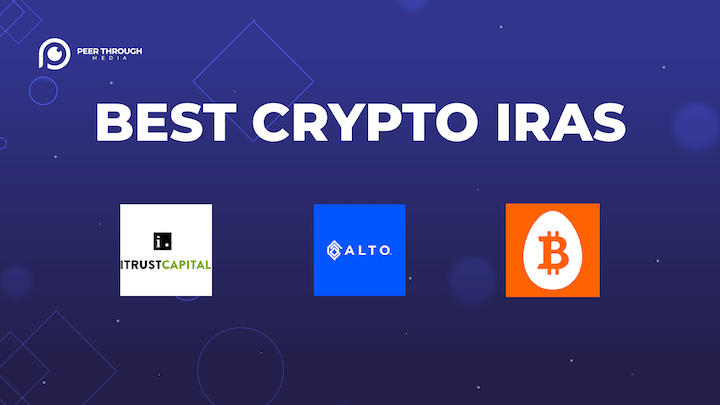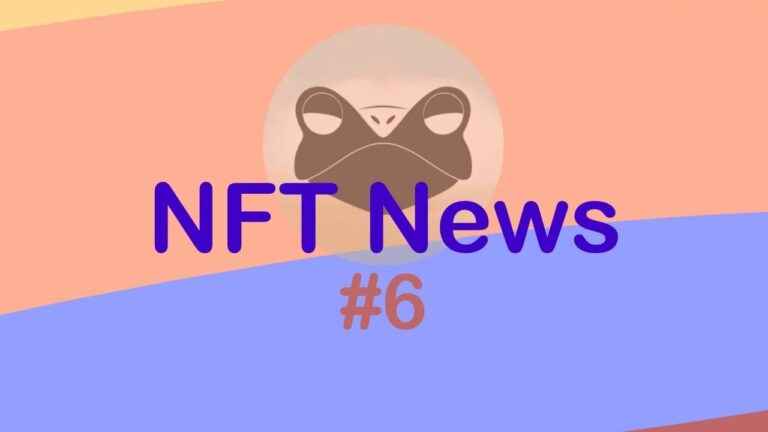Best Decentralized Derivatives Exchange (Crypto Perpetuals)
This article will cover the best decentralized derivative exchanges and protocols in crypto. We’ll briefly define what a derivative is and why it’s used.
From there, we will dive into today’s top decentralized derivatives platforms.
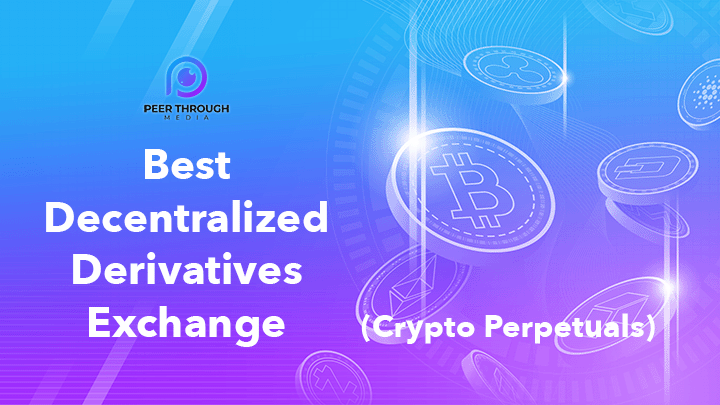
What is a Derivative?
A derivative is a constructed financial instrument whose value is based (“derived from”) an underlying financial asset or index.
The definition of a financial derivative is incredibly wide and so there are thousands of types and variations of derivatives. Gold, stocks, coins, indexes or really any contract can create a derivative.
In the crypto world, derivatives are generally created through a mixture of backing collateral, tokenomics and smart contracts.
Example of a Simple Crypto Derivative
For a simple example of a derivative, a common idea in the crypto world is to make an on chain derivative of a stock. Synthetic Assets is another common name for this type of crypto derivative.
Mirror Protocol is a popular example of synthetic stocks. Users can, for instance, buy mAPPLE token, a derivative that “mirrors” the price of apple stock.
This 1:1 derivative shifts an asset from a Monday-Friday 9-5/ institutionalized stoc to an on-chain coin that can be traded 24/7, 365
However, usually derivatives are far more complex than simple 1 to 1 mirrorings.
What Are Derivatives Used For?
Derivatives are primarily used to either hedge risk or assume greater risk, and therefore speculate on greater rewards.
The two most popular derivatives are futures and options.
What is a Future?
A future is a contract with an agreed upon purchase price of an asset on a future date. At the core of the idea, you can think of Futures as a way for a farmer to lock in the price of his crop.
Over-simplified Futures Example
Company X agrees to buy 1000 bushels of wheat from farmer Dan at $7 a bushel on May 15. This locks in Farmer Dan’s $7000 revenue.
Company X also either receives a predictable price of wheat, or they are speculating that the market price of wheat will rise to $8 by May 15, so they can instantly flip for a profit of $1000 dollars.
Now of course, the modern economy is far more complex. So futures are usually bought and sold amongst a variety of parties, on exchanges, before their expiration date. Most parties never actually touch the bushels of wheat. But you get the idea.
What is a Crypto Perpetual?
A crypto perpetual is a futures contract on a particular cryptocurrency that does not have an expiration date. The price of the future is held in check by charging a fluctuating funding rate to either the short position or the long position.
Crypto perpetuals are usually traded with leverage and therefore use the idea of account margins and liquidations.
Example of a Crypto Perpetual
Dan deposits $1000 USDC into his margin account on a decentralized perpetuals exchange.
The price of ETH is $2000. Dan wants to go 3x Long ETH. So, he buys 1.5 ETH using his $1000 as collateral.
Dan now has exposure to $3000 worth of ETH from his $1000. This position will remain open until Dan closes it for:
A gain – Ex: ETH is now $2500
(1.5 x 2500) – (1.5 x 2000) = $750 = Account value now $1750
A loss – Ex: ETH is now $1500
(1.5 x 1500) – (1.5 x 2000) = – $750 = Account value now $250
Or is forcibly liquidated. Perpetual exchanges are automated so that they forcibly close an under backed position before losing money. Liquidations often have a minimum collateral ratio and a penalty. But for our example we’ll assume a par value close and no penalty.
Liquidation price of ETH = (1.5 x liq price) – (1.5 x 2000) = $1333.33
That means use lose all of your $1000 USDC if ETH falls to $1333.
Crypto Perpetual Liquidations
That’s why margin trading can be dangerous. You amplify your gains and losses. And on liquidation you don’t just have losses, you actually lose all of your positions, meaning you’re no longer hodling. You can’t make it back if the price rises again.
Related: Centralized exchanges with no kyc
Centralized vs Decentralized Derivatives Exchange
Crypto derivatives exist on both centralized and decentralized exchanges. Centralized exchanges with derivatives tend to have the advantages of a clean user interface, added benefits like Futures trading bots, and often more coin pairings and deeper liquidity.
Decentralized exchanges however don’t take custody of your funds, don’t require KYC, run transparently through smart contracts, and often times have unique pairings due to open community run AMMs.
At this point in the game, centralized exchanges likely Kucoin or Binance futures likely have a better trading experience and lower fees. However, decentralized exchanges are making head way. It’s my personal opinion that decentralized exchanges will be the norm and superior to centralized excahnges in the not too distant future.
So with that said, let’s get into the best decentralized derivatives platforms for trading crypto perpetuals.
Best Decentralized Derivatives Exchange – Crypto Perpetuals
The best decentralized Derivatives Exchanges for Crypto Perpetuals are:

dydx
dydx is the largest decentralized Derivatives Exchange with over 500 Million in total locked value (TVL) as of the time of this writing.
When it comes to the tech and user interface, dydx is likely the best derivatives exchange as well. We wrote an entire deep dive DYDY review if you want to learn more about this perpetuals exchange.
The exchange was started by an ex-coinbase engineer and has achieved some pretty remarkable things since its existence.
As of now, the exchange runs on an Ethereum layer 2 powered by Starkware. You interact directly from your Ethereum metamask. You simply pay gas to deposit and withdraw. Once on the layer 2 trades are gas free and instant. The order book and UI is very similar to a centralized exchange. Overall, the user experience and low fees on dydx make it a winner.
dydx Fees
dydx charges a maker and taker fee when trading crypto perpetuals. Users can stake dydx token, reach specified trading volume limits, and own hedgie nfts to receive fee discounts. However, in general, dydx fees start at a low .02% Maker and .05% Taker.
Fees can go down to 0% maker and .02% taker.
There are also network gas fees to deposit and withdraw, but often times dydx will even reimburse your gas fees.
One interesting thing to note, while Dydx is currently the largest derivatives exchange it is also currently based around Ethereum (on a layer 2). Recently, the team made an announcement that they will be creating their own app chain on Cosmos. What this move means for the dydx token, trading experience, and the crypto ecosystem in general remains to be seen.
However, dydx is certainly worth keeping an eye on. As of now, it is still the king of decentralized perpetuals trading.
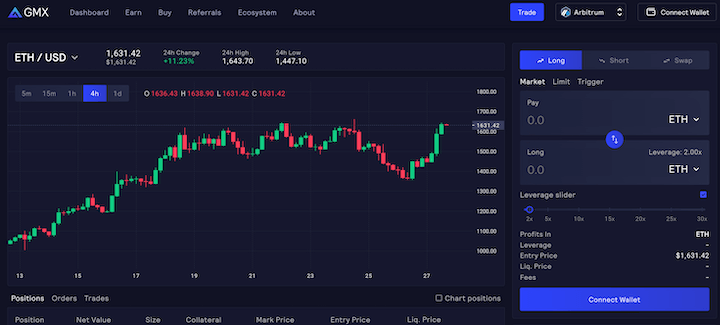
GMX
GMX is the second largest decentralized crypto perpetuals trading platform. Users can trade perpetuals on Avalanche, and Arbitrum. There isn’t an order book like dydx, but the user interface is intuitive and clean.
Furthermore, rather than your margin being held in USDC, GMX allows a wide variety of coins to be used as collateral – AVAX, ETH, MIM, USDC and more.
GMX charges a .1% open fee and a .1% close fee on all positions. While this is higher than dydx, it is equal or better to the rest of the exchanges on the list.
Further good news is, here is a GMX promotion code to get 5% off fees on GMX. (Promo Code: PTMbiz )
This GMX discount code – PTMbiz – works for perpetuals trading on GMX on both Arbitrum and Avalanche.
The other good news is, token holders earn a piece of the platform fees. If you are interested in buying and staking the GMX governance token or providing liquidity, via their GLP token, you’ll earn an APR from the platform.

Perpetuals Protcol
We couldn’t talk about decentralized perpetuals trading without mentioning the Perpetuals Protocol (PERP). Perp is a decentralized derivatives exchange based on Ethereum and Optimism.
Similar to GMX the perpetuals protocol also charges a .1% fee on each order no matter if you are a maker or taker.

Kwenta Perpetuals Platform
Kwenta is a perpetuals exchange based on Optimism that is part of the Synthetix family. Synthetix is a protocol that enables developers to create synthetic assets on chain, perform atomic swaps and more.
Kwenta derivatives exchange runs on Optimism and is built using synthetix.
The design is sleek, users can go up to 25x leverage and liquidity is excellent. However, fees are currently .3% for taker and .1% for maker.
Conclusion: Best Decentralized Derivatives Exchange – Perpetuals
Decentralized derivative exchanges are growing in number and quality. Perpetuals, futures and other derivatives that were once only available through centralized exchanges, now are competitively available as decentralized applications on Ethereum and other blockchains.
dydx would be the clear winner due to its lower fees and great trading interface BUT with their upcoming move to Cosmos AND the progression of a lot of their competitors – the race is still too early to call. GMX has been gaining a lot of popularity lately with the rise of Arbitrum.
The good news is, you can try them all out. With a decentralized app, it takes little more than a click of “connect wallet” to begin trading.
Stay safe and smart though. Leveraged trading is certainly an easy way to lose a lot of money. Something I sadly know from experience :/
Note: None of the information in this article should be considered investment advice. Crypto trading, particularly leveraged crypto trading, is extremely risky. Always do your own research.
But that is a story for another time. Thanks for reading and happy trading.

